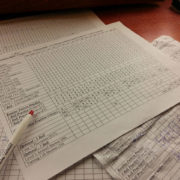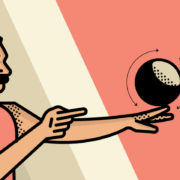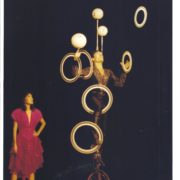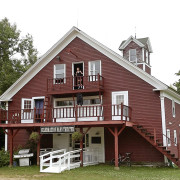Act Creation Method #3 – The Pixar Method

This week, I met with Philadelphia juggler, Andrew Scharff, to help him polish some acts. We retooled his cigar box and diabolo acts in anticipation for his upcoming contract on Celebrity Cruise’s ship Solstice, where he’s working for the first part of 2015.
We worked mostly on pushing and pulling the acts – making them more dynamic in their pacing, blocking on stage, and emotional appeal. Towards the end of our first workshop, we started talking about act creation methods. I put the work of the day in terms of The Postcard Method, The Storybook Method, and Fritz Grobe’s ABC/”Little Pieces of Shit” method (more on that later!) He asked me if I’d heard about the Pixar Method. I hadn’t! Here’s what he was talking about:
In 2011, Pixar storyboard artist Emma Coats published a list of “story basics” – a series of writing guidelines she’d picked up from senior writers in her department. Andrew was most excited about principle #4, a basic fill-in-the-blank writing prompt that allows for a strong narrative arc:
Principle #4 – “Once upon a time there was ___. Every day, ___. One day ___. Because of that, ___. Because of that, ___. Until finally ___.”
Storywriting 101, right? You’ve got a main character, some exposition, an interrupting action that drives the plot, and a resolution. It’s a bit formulaic (uh, because it’s a formula!), but it’s an interesting lens to look through. Applying this technique to variety acts with this rubric would get you out of “juggler brain,” where you focus on doing hard stuff for the sake of doing hard stuff, and instead focus on doing tricks that are meaningful in some way. This formula applies mostly to character-based, narrative acts, but could be used for more straight-variety pieces, too.
Let’s take this partner acrobatics act by my friends Lauren Breunig and Ryan Freeze as an example:
Once upon a time there was an old man and a nurse.
Every day, she would look after him.
One day, he stumbled around during his exercises.
Because of that, he and the nurse accidentally did some amazing tricks.
Because of that, he got too excited and needed his medication.
Because of that, he remembered what it was like to be young again.
Until finally it was time to go home.”
I know what you’re thinking! “…great, Thom. That’s a nice way to look at an existing act, forcing it to fit this Pixar thing. That’s not useful, though – how can we create something using this idea?”
Here’s one way of reverse-engineering an act, using this formula as a starting point:
Take a stunt you want to turn into part of the act. This could be a big meaty trick, a “Postcard Moment,” or any other thing that has some narrative or dramatic importance to it. We’ll put this moment in one of the blanks in the “because of that” section. For our purposes, let’s use the idea of juggling a slippery bar of soap. (Everyone’s got a couple of soap tricks, right? Old hat.) Plugging that into the formula, we get this:
Once upon a time, there was a ____. Every day, he would ____. One day, he _____. Because of that, he ____. Because of that, the soap slipped out of his hands into the air. He tried to catch it, but couldn’t. Because of that, he _____. Until finally, _____.
The next step is putting that in context. What could lead to soap flying through the air? In this soap case, maybe our character is washing dishes. Why is he washing dishes? Maybe he was out of clean dishes, and wanted to put some supper on the plate.
Once upon a time, there was a man. Every day, he would eat lunch. One day, he was out of clean dishes. Because of that, he needed to wash his dirty dishes. Because of that, the soap slipped out of his hands into the air. He tried to catch it, but couldn’t. Because of that, he _____. Until finally, _____.
What’s the payoff here? Can we find a relationship between the lunch and the soap? Instead of having an extra, contrived prop in the act, wouldn’t it be nice if it all tied in together? What if we had the character accidentally eat the bar of soap? The character would have to be pretty absent-minded or distracted for him to accidentally make a soap sandwich. How could we make that happen?
Once upon a time, there was a man who loved sandwiches and watching sports on TV. Every day, he would eat lunch when the game was on. One day, he was out of clean dishes. Because of that, he needed to wash his dirty dishes. Because of his love for televised sports, he didn’t pay attention to what he was doing. Because of that, the soap slipped out of his hands into the air, landing in his sandwich. Eyes on the TV, he fished around in the sink for the bar of soap. Because of that, he didn’t realize it wasn’t the soap he picked up. Until finally, he closed his sandwich, put it on the dirty plate, and took a big bite of soap.
Is it perfect? Nope! Did we create the bones of an act that has a beginning, middle, and end that has a juggling stunt placed in context? Absolutely. One of the nice things about acts with a narrative structure is that there are lots of ways to add virtuosic skills, as well as clever ways to incorporate pretty “Postcard Moment“-style images. Here are a few ideas off the top of my head that could be used to flesh this hypothetical “soap and sandwich” piece out.
– Soap juggling – frantic, arms reaching upwards
– Bubbles coming out of the sink
– Blind tricks / cutting a sandwich blind / almost cutting a finger off
– Plate manipulation
– Stacking dishes very tall, not knocking them over – pretty images of towers of cups leaning over the sink
– Making a mess in the sink – water splashing over the countertop
– Bubbles coming out of the mouth after biting into the sandwich before the final blackout
Add some of these ideas, and pow! you’ve got a nice act that’s interesting to watch and easy to follow.
When thinking up ideas to flesh an act out, don’t censor yourself at first. The important thing is generating lots of ideas to go over later. After the thoughts are on paper, you can start picking through them to find related threads and see where the strongest ideas are.
Do you have any acts that follow this narrative arc? How might this particular thought process help you with a project you’re working on? I’d love to hear in the comments!


![picture [6]](https://thomwall.com/wp-content/uploads/2019/08/picture-6-180x180.jpg)






This is an interesting idea for act creation. I haven’t thought of it before. Going to bookmark this so I can read it again in a few weeks when I have more time to get back to training…
Also, this could be called the “Biz Markie” Method. Just a Friend fits this narrative pretty well: https://www.youtube.com/watch?v=9aofoBrFNdg